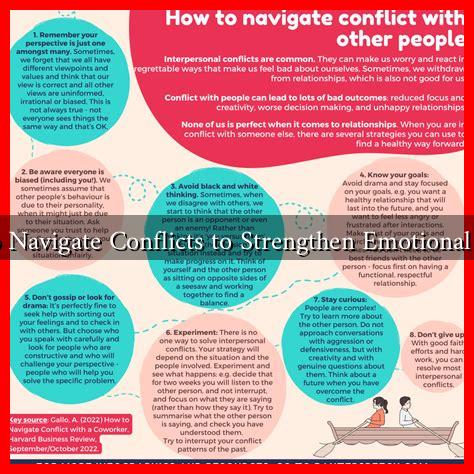-
Table of Contents
- How to Navigate Conflicts to Strengthen Emotional Bonds
- Understanding the Nature of Conflict
- Strategies for Navigating Conflicts
- 1. Active Listening
- 2. Use “I” Statements
- 3. Find Common Ground
- 4. Take a Break if Needed
- Case Studies: Successful Conflict Resolution
- The Role of Emotional Intelligence
- Conclusion: Turning Conflict into Connection
How to Navigate Conflicts to Strengthen Emotional Bonds
Conflicts are an inevitable part of any relationship, whether personal or professional. While they can be uncomfortable and challenging, navigating conflicts effectively can actually strengthen emotional bonds. This article explores strategies for managing conflicts in a way that fosters understanding, empathy, and connection.
Understanding the Nature of Conflict
Before diving into conflict resolution strategies, it’s essential to understand what conflict is and why it occurs. Conflicts often arise from:
- Differences in Values: Individuals may have different beliefs or priorities that lead to disagreements.
- Miscommunication: Poor communication can result in misunderstandings and assumptions.
- Emotional Triggers: Past experiences can influence how individuals react to certain situations.
Recognizing these underlying causes can help in addressing conflicts more effectively.
Strategies for Navigating Conflicts
Here are several strategies to navigate conflicts while strengthening emotional bonds:
1. Active Listening
Active listening involves fully concentrating on what the other person is saying, rather than just waiting for your turn to speak. This technique can help in:
- Validating the other person’s feelings.
- Gaining a deeper understanding of their perspective.
- Reducing defensiveness and promoting open dialogue.
For example, in a workplace setting, a manager who actively listens to an employee’s concerns about workload can foster a more collaborative environment.
2. Use “I” Statements
Using “I” statements can help express feelings without placing blame. For instance, instead of saying, “You never listen to me,” try, “I feel unheard when I’m interrupted.” This approach encourages a more constructive conversation.
3. Find Common Ground
Identifying shared goals or values can help bridge the gap between conflicting parties. For instance, in a family dispute over holiday plans, focusing on the desire to spend quality time together can lead to a compromise that satisfies everyone.
4. Take a Break if Needed
Sometimes, emotions can run high during conflicts. Taking a break allows individuals to cool down and reflect on the situation. This pause can lead to more rational discussions later on.
Case Studies: Successful Conflict Resolution
Several organizations have successfully navigated conflicts to strengthen their teams:
- Google: The tech giant encourages open communication and feedback among employees. By fostering a culture of transparency, Google has been able to resolve conflicts quickly and maintain strong team dynamics.
- Starbucks: The company emphasizes empathy and understanding in customer service training. This approach not only resolves customer complaints but also strengthens the emotional connection between employees and customers.
The Role of Emotional Intelligence
Emotional intelligence (EI) plays a crucial role in conflict resolution. Individuals with high EI can:
- Recognize their own emotions and those of others.
- Manage their emotional responses effectively.
- Empathize with others, leading to more compassionate interactions.
According to a study published in the Journal of Organizational Behavior, teams with high emotional intelligence are more successful in resolving conflicts and maintaining strong relationships.
Conclusion: Turning Conflict into Connection
While conflicts can be challenging, they also present opportunities for growth and deeper emotional connections. By employing strategies such as active listening, using “I” statements, finding common ground, and leveraging emotional intelligence, individuals can navigate conflicts more effectively. The key takeaway is that conflicts, when handled with care and empathy, can ultimately strengthen emotional bonds rather than weaken them.
In summary, embracing conflict as a natural part of relationships and approaching it with a constructive mindset can lead to stronger, more resilient connections. Remember, the goal is not to avoid conflict but to navigate it in a way that fosters understanding and unity.

